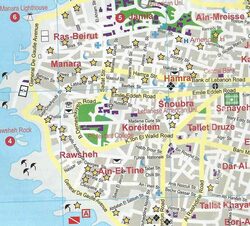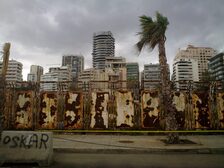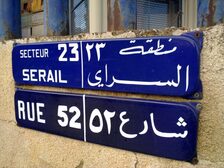About Beirut - An Explosive Thriller

I started writing Beirut - An Explosive Thriller in late 2009, just after a British literary agent rejected Olives after a ‘full read’ with the comment that it wasn’t dramatic enough.
Right, I thought. If you want dramatic...
I finished in June 2010, but it wasn’t until spring 2011 the book was picked up by literary agent Robin Wade, who signed me and shopped it to fourteen of London’s finest. Seven months later, to a man, they rejected it.
The rejection that hurt most praised the book’s qualities but noted the editor in question ‘couldn’t see it selling in supermarkets’:
"There are lots of elements to it that I like – there’s an austere, almost Le Carre feel which I like and the author can clearly write. The dialogue and plotting stood out for me in particular. I’m afraid though that it is – for my purposes – a bit too low-key; the ‘commercial’ bit of my job title requires me to pick out titles which are going to appeal directly to supermarkets and the mass-market, and I feel that this would be too difficult a sell in that context."
It was that reaction pushed me over the edge into self-publishing. There was clearly a major change – and massive contraction – taking place in the world of ‘traditional’ publishing and it wasn’t favouring a new author writing hard-to-peg novels about the Middle East.

Some of the editorial feedback had mentioned the book as ‘Set in Beirut, that war-torn city’. This was even more infuriating than the supermarket stuff, as Beirut – An Explosive Thriller is set in contemporary Beirut, well over 20 years after the civil war ended. It either spoke to a lack of care on the part of the editor, who hadn't bothered to read the material before rejecting it - or to the sheer power of the 'looks like Beirut' meme.

Beirut Today
Beirut today is a complex city, sexy and shabby, filled with promise and hopeless, vibrant and drab, it rarely fails to entertain and challenge. Plagued by power cuts, creaking infrastructure and endemic corruption, Beirut is full of life, creativity and celebration – even if that celebration sometimes takes on a brittle, desperate air.

Beirut still bears the scars of the war – although they’re fading with the years, the deep-rooted problems of sectarianism and vested interest frequently combine to frustrate attempts to make the most of Lebanon’s rich natural and human resources. All too often, both are squandered.
Lebanon itself remains a country of three parts – to paint it with an impossibly broad brush, Muslim in the south, Druze in the mountains and Christian to the north. It constantly teeters on the edge of a precipice of its own making. Israel to its south and Syria bordering inland are rarely helpful influences. It’s the perfect place for Gerald Lynch, wilfully unconventional and wild as he is. In Olives - A Violent Romance, the reader only saw Lynch through Paul Stokes’ eyes and that certainly wasn’t a sympathetic viewpoint.
In Beirut we get to see Lynch in the round, including his own circle of friends and colleagues, from tired-eyed policeman Tony Chalhoub through to smouldering beauty (and cathouse madam) Marcelle Aboud. And then there’s fat Palmer from the embassy and the wily Brian Channing, deputy director for security and public affairs.
We also start to uncover some of Lynch’s backstory, the kid on the Falls Road they called Gerry.

Research
One thing that has amazed me over the course of writing Beirut - An Explosive Thriller is that I haven't been arrested. My Google life has been extraordinary and has mostly involved things like weapons, military assets, intelligence, police and other deeply dodgy stuff. I can't imagine how writers did this stuff before Google - they must have spent months in the library, ordering books and poring through piles of obsessive esoterica.
Actually, come to think of it, I have ordered books and stuff - some of which (I didn't realise until too late) had the potential to attract unwelcome attention down at Sharjah Post Office, too! Luckily the customs chaps there have long had me down as a harmless eccentric, so they don't look too closely at the books I bring in.
I've also depended on the expertise of a number of people as well as quite a lot of walking around that most glorious of cities in the company of various lovely colleagues or on my tod. There's nothing quite like just walking around a great city and Beirut certainly rewards the experience with an enduring intensity. Put it all together and you have a demonstrable track record of a deeply unhealthy interest in a lot of things that go bang and otherwise kill people.
That includes an awful lot of phone calls and emails with people centering on military helicopters, missile systems and toxic substances and a nasty obsession with the military and intelligence services of a number of countries. As well as mooching around certain cities day and night taking photographs and generally just acting strangely. Nobody's batted an eyelid. I'm not sure whether I'm relieved or worried...
The Soviet Oka Missile
The warheads in Beirut are, worryingly, solidly researched. The Oka class missile (Designated by NATO as the SS-23 Spider) was developed in 1980 by the Soviets to carry both conventional and nuclear payloads and be launched from mobile launchers. The nuclear warhead was detachable. A number of these missiles were covertly deployed in the late 1980s to Warsaw pact countries to get around INF treaty (Intermediate-range Nuclear Forces) limitations and a round of Soviet obfuscation took part during the negotiation of the treaty that made it hard to trace quite what was deployed and stored quite where. Over 120 missiles were involved in the redeployment – possibly including nuclear warheads.
There is some evidence that loading equipment associated with handling these warheads was part of that deployment. Adding to the confusion, Czechoslovakia split into two nations. Stockpiles of the Oka were destroyed by both the Czech Republic and Slovakia – it is now obsolete and all remaining missiles have been destroyed.
Well, apart from two...

Beirut's famous Raouché rocks are a big attraction and something of a symbol of the city. Quite why beats me, to be honest...

This image, for some reason, says 'Beirut' to me. I guess the modern buildings, the decay and the palm tree sort of work as a reflection of the city.

The Hamra district, all glitzy shops and wacky bars, pubs and clubs. It comes alive in the evenings and sparkles with its own special, brittle, fervour.

When I'm in the city, I'm very fond of just hitting the streets and following my nose, walking for hours on end through manic traffic and peaceful side streets past modern glass-enshrouded office blocks and crumbling Ottoman houses.

A servees or shared taxi. They are never less than amazingly ramshackle. You basically flag these guys down and join the other passengers to get to where you want to go via where they're going for a few Lebanese pounds. It amused me wildly to have Gerald Lynch use these as his preferred means of transport. You'll notice this gentleman has his bumper in his boot. I've been in servees where you can see the road through the floor...
